The Khmer Rouge. The Killing Fields. That’s what we knew of Cambodia’s past- just names, really, points on a timeline in some history lesson.
This isn’t history that happened hundreds of years ago to some vaguely-remembered people. Karen and I were kids when the Khmer Rouge took advantage of Cambodia’s political turmoil (caused in part by the US war in Vietnam) and marched into Phnom Penh. The Cambodian people we interact with every day were touched by what happened here.
Untangling Cambodian history is a difficult task. This article is a good summary, detailing the push and pull among Prince Norodom Sihanouk, General Lon Nol, President Richard Nixon, the Vietcong, and the Khmer Rouge.
Visiting sites around Phnom Penh helped us to see the human faces behind the history. First, we stepped onto the grounds of Tuol Sleng Genocide Museum.
Formerly a high school, this complex of four cinder block buildings is better known as Security Prison 21 (S-21), one of hundreds of Khmer Rouge prisons. We timed our visit so we could see a documentary that shows once each morning. As a newcomer to Cambodian history, I was amazed at the historical footage of the prison (like the Nazis, the Khmer Rouge meticulously documented their atrocities). As a video producer, I cringed at the lifeless narration and interminable running time.
Escaping the movie, we wandered through the buildings, floor by floor. In Building A, stark rooms with ramshackle beds and leftover belongings.
On each new floor, in each new building, conditions became more grim. Hastily-constructed brick rooms still stand. What must it have been like to be confined here, no idea what would happen next… or when?
From 1975 to 1979, the Khmer Rouge’s resident madman, Pol Pot, tried his best (worst) to convert the country into a “self-sufficient agrarian communist state.” People who weren’t down with that idea wound up at S-21. In his zeal to eliminate educated people, professionals and those who spoke multiple languages, Pol Pot did away with an entire generation of Cambodia’s best and brightest. They were tortured until they “confessed” their crimes and incriminated family members and friends. Walls of photos put us face to face with the victims of S-21.
Karen commented that her reaction wasn’t as emotional as she expected- it wasn’t a “burst into tears” kind of place. For me, it was about contemplation. I gazed into the eyes of prisoners in the photographs and tried to understand what they went through.
Strangely, as you wander the buildings of S-21, there is very little information available in Khmer, English, or any other language. I’ve worked on some museum exhibits in my time, and it’s clear to me that with some interpretive signs and better use of that documentary footage, this memorial could do a really good job of educating tourists and locals alike about Khmer history. It’s a missed opportunity; maybe the flow of tourist dollars from the small entry fee will help it improve in the future.
For many detainees, S-21 was the end of the line. However, as the influx of prisoners increased, transports began moving prisoners to camps outside of Phnom Penh. These were the “killing fields.” Our next destination.
The ride to Choeung Ex, 17 kilometers outside Phnom Penh, is a dusty one. If you take a tuk-tuk, as we did, be prepared with a dust mask (or napkin or handkerchief).
Now a memorial, Choeung Ek charges a higher entry fee than S-21, and the money is well-spent on an excellent audio tour offered in several languages. A Khmer Rouge survivor narrates the path prisoners took, from their first dizzying moments of arrival, to torture or hard labor, to a brutal death (prisoners were bludgeoned, one by one, to save on expensive bullets).

The Killing Fields. The depressions in the ground are areas where mass graves were excavated and bodies removed.
Not all the bodies were exhumed, and as the seasons come and go, prisoners’ teeth, clothing and other personal effects come to the surface around the memorial grounds. Crews clean them up every few months.
Slowly walking through the site, we reflected on the lives lost here, ending our circuit at the memorial stupa. An impressive structure… and look more closely at what’s inside.
It struck me as odd to “show off” the skulls of the dead, with one cabinet actually open to curious fingers (there is a “DON’T TOUCH” sign nearby).
Then again, the stupa is a focal point for remembrance ceremonies every year, perhaps a fitting end to the journey these bones have taken.

Yes, there is a souvenir shop at the Killing Fields. At least it sells tasteful things, like books and DVDs about the Khmer Rouge era.
Pol Pot was driven out of Phnom Penh in 1979, and Cambodians once again rejoiced. But once again, the celebration was short-lived. The Khmer Rouge continued to fight for power in a conflict that would last another two decades.
Our exploration of Cambodia’s past continues in a future post, as we discover how immediate this past really is for many Khmer people.

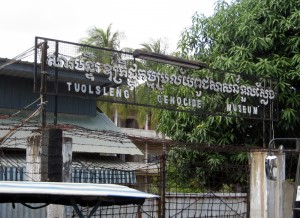
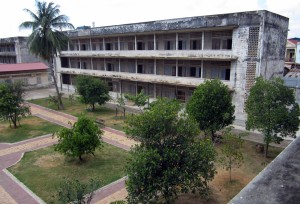
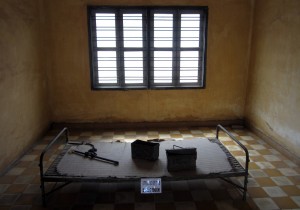
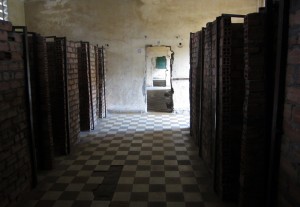
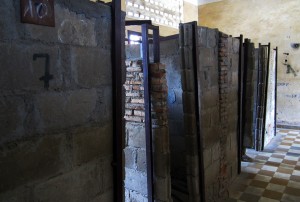
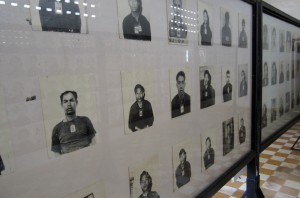
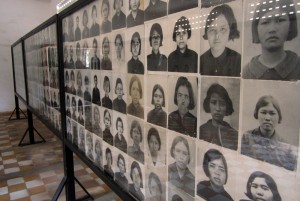
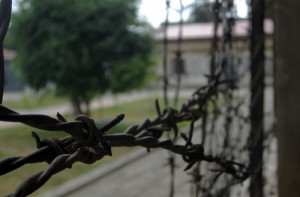
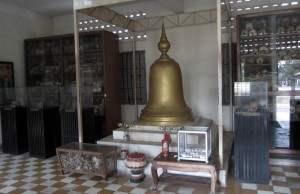
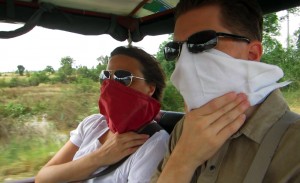
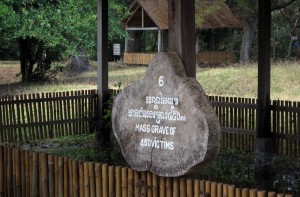
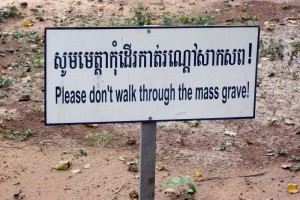
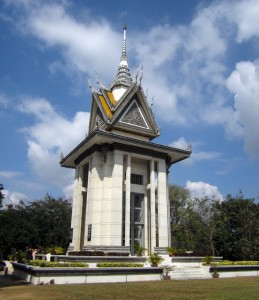
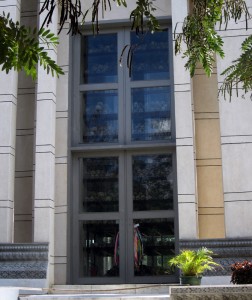
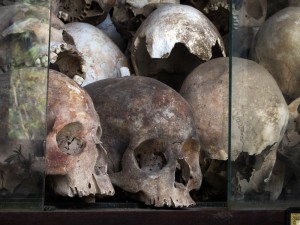

This post makes me even more thankful that God has given me the gift of a safe place to live. I’ve read some books about what the Cambodian people went through during this horrible time. I cannot even begin to imagine what it would be like to live under those circumstances. This is really a sad time in our worlds history. Man’s inhumanity to man is a hard thing to understand. All we can hope is that some day we can all live in peace. Scott
Amen Scott.
It has been tough visiting sites like this and other war history locations. It baffles me that humans are capable of this. I guess anything is possible. So is peace, so I hold hope for us all.
Fascinating. I knew a little bit about the history and I’ve always been very curous to see “Security Prison 21” and to a lesser degree the killing fields, but your first hand accounts are priceless. As odd as it may sound, Cambodia is one of the few places I’ve always wanted to visit. Maybe soon.
I’m sure that you and Karen are spending a lot of time generating this content. I know from my own travels how much time can be spent simply wading through the sea of images and jotting down my own small thoughts. But to take it up several notches and edit and compose and craft and post while you’re on the road is very time consuming (and technically challenging), I’m sure. Many thanks for your efforts, and please keep it up!
Thanks for the encouragement, Bob! It’s a balancing act. It does take time, so I have to decide how much time I want to spend editing at a desk in Phnom Penh versus actually going out and experiencing Phnom Penh. Creating videos and detailed posts is important to me (it’s part of what I want to get out of this trip), so we’re building some “work” days into the schedule. It sure is nice when we can find $15/night hotel rooms for those days, as we did in Siem Reap!
As for visiting Cambodia, you should definitely do it. The country is at an interesting place right now, pulling itself out of its history. There could be a lot of touristy development in the near future, but they also have issues to deal with regarding corruption, public health, etc. A fascinating country to learn about- plenty of tourist infrastructure without being a sanitized experience. And of course, plenty of cool stuff to see at Angkor Wat (blog post coming soon, I promise!).
Bob, definitely visit Cambodia. It’s not easy and some things will downright disgust you. Yet there is beauty when you take the time to look for it. Most people, who are not drivers or selling stuff to tourists, are amazingly friendly and giving. Especially in the more rural areas, we had some lovely experiences. Such interesting history. Go soon, as I think in 10-20 years it will be different.